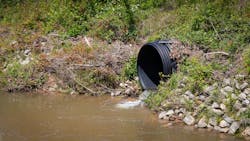The U.S. Environmental Protection Agency (EPA) announced that compliance with Clean Water Act (CWA) permits over the past five years has improved significantly.
In fiscal year (FY) 2018, EPA and 47 states agreed to collaborate on a goal to reduce significant non-compliance (SNC) among facilities permitted under the Clean Water Act by 50 percent over five years.
Now, the agency announced that the collaborative effort has achieved its goal: the national SNC rate has been reduced from 20.3 percent at the start of 2018 to 9.0 percent today.
The agency says that this improvement in CWA compliance will produce substantial benefits for public health and the environment.
“Five years ago, EPA set an ambitious goal for cutting the rate of significant noncompliance with Clean Water Act permits in half,” says Larry Starfield, acting assistant administrator for EPA’s Office of Enforcement and Compliance Assurance. “Today I’m pleased to announce that we have met and exceeded that target achieving a historically low rate of 9 percent. This notable achievement speaks to what EPA and the states can accomplish together to improve compliance and reduce Clean Water Act violations.”
SNC is a designation given by EPA to facilities with violations of a more serious nature and cause for concern. For decades prior to this initiative, over 20 percent of CWA permitted facilities had “significant non-compliance” (SNC) level violations with their water discharge permit, including violations for exceeding permitted pollutant discharge limits, not meeting enforcement order or permit requirements, and not timely reporting compliance data or sometimes at all.
Setting the Goal
In response to these persistent CWA non-compliance problems, EPA in 2018 set a goal to cut the level of SNC violations at roughly 46,000 CWA regulated facilities in half over 5 years. EPA immediately reached out to the states to partner with them in this effort and to find ways to achieve the goal together. In 2020, EPA took another step and made this effort one of the EPA enforcement program’s National Compliance Initiatives (NCIs).
“Virginia is honored to have been invited to serve as the state co-chair of this initiative. Over the long term, Virginia has achieved a low rate of SNC, and we are pleased to provide leadership in this area,” says Travis Voyles, Virginia’s Acting Secretary of Natural and Historic Resources. “This initiative is a tremendous example of the importance of an effective partnership between EPA and the states.”
EPA says that achieving a 50 percent cut in the rate of facilities with SNC level CWA violations improves public health and the environment by:
- Reducing the number of permitted facilities with SNC-level violations by roughly 4,000 fewer facilities.
- Reducing the amount of illegal discharges of water pollution by 23.7 million pounds through enforcement cases concluded over the past three years.
- Creating lasting, strong, reliable EPA/state partnerships which can be mobilized to achieve additional successes.
- Assuring EPA and states have a complete compliance data set to allow quick recognition of and proactive response to CWA non-compliance.
- Increasing attention on the remaining non-compliant facilities and, in turn, increasing the level of compliance across all CWA permittees.
The Power of Data Reporting
Underlying this achievement is EPA’s 2015 CWA rule that requires all facilities to electronically report water discharge pollutant monitoring data to EPA and the states. Prior to this effort, EPA was unable to determine compliance and calculate a reliable rate for SNC for the full 46,000 CWA permitted facilities due to a lack of consistent or accurate data reporting.
As a result, improving the completeness of the data became a key focus of the initiative to assure that EPA could accurately determine noncompliance and the SNC rate. Access to electronic data on compliance by the universe of regulated parties is not available under most environmental programs.
EPA now has accurate data for determining compliance for CWA facilities for about 96 percent of CWA individually permitted facilities for almost every state in the country. Now, EPA and states can clearly see which facilities are in violation of their permit and prioritize these violators for notification, compliance assistance, financial assistance, or enforcement to assure that public health and the environment are protected.



